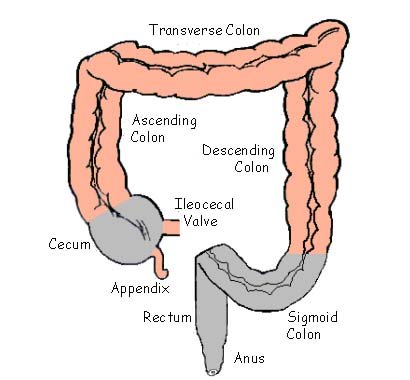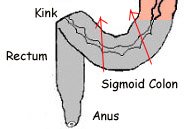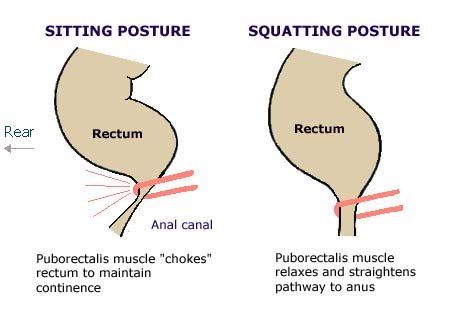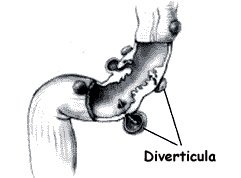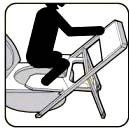|
Diverticulosis.. Why Is The Sigmoid Colon So Vulnerable?The sigmoid colon is the most common site where diverticulosis occurs. There is a reason why.
The human colon is designed with squatting in mind. It has built-in natural obstacles to help maintain continence, ie: to prevent the accidental release of waste.
One of these obstacles is the natural kink (bend) where the sigmoid colon joins to the rectum. This kink must be 'released' to enable waste to flow to the rectum without restriction. The opening up of the kink can only happen in the squatting position, when the left thigh - pressing against the abdomen - supports and lifts the sigmoid colon upwards.
There is also another natural obstacle that lies between the rectum and anal canal (see diagram below). This second kink is formed when the puborectalis muscle - in the sitting position - grips the rectum in the choked position. However, in the squatting position, the puborectalis muscle relaxes its grip to release the kink and straightens the final pathway to the anus so as to allow waste to pass out easily.
When one uses a sitting toilet, the natural obstacles in the sigmoid colon, rectum and anal canal remain in place. This explains why it is so difficult to evacuate waste comfortably and easily, and the need to strain. Yet, despite the straining and pushing downwards, evacuation can never be complete because of the kinks. Just as water is held back by a dam, the kinks in the colon cause waste to back up, stagnate and build up in the sigmoid colon and lower regions of the colon. Over time, the combination of fecal waste stagnation and frequent straining causes the weaker parts of the colon to give way and protrude outwards.
This is because the colon works as intended by Nature in the squatting position. The rectum is in a relaxed and straightened, the left thigh supports and lifts up the sigmoid colon to open up the kink. Without any obstruction in the colon, and aided by gravity, waste flows easily from the sigmoid colon to the rectum and out through the anus. Evacuation is quick, easy and complete. This explains why in Asia and Africa, where squatting is widely practised, diverticulosis and diverticulitis are extremely rare. SIDENOTE Close This Sigmoid Colon Page
|
The Best Toilet Converter in The World Today!


Helping People All Over
The World Achieve
Good Health Through
Correct Toileting Posture
Watch video on the
origin and story of
the Sandun-Evaco
toilet converter
All about Life,
Hope and Truth...
FREE:
One of the most
astounding books
you will ever read
in your life!




